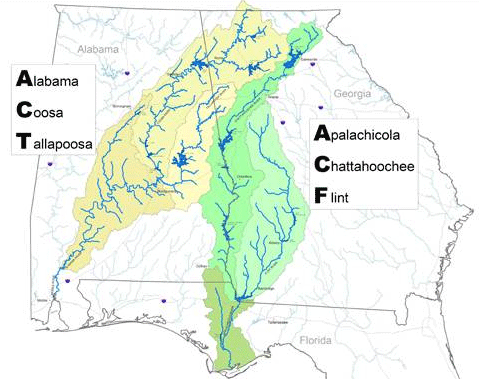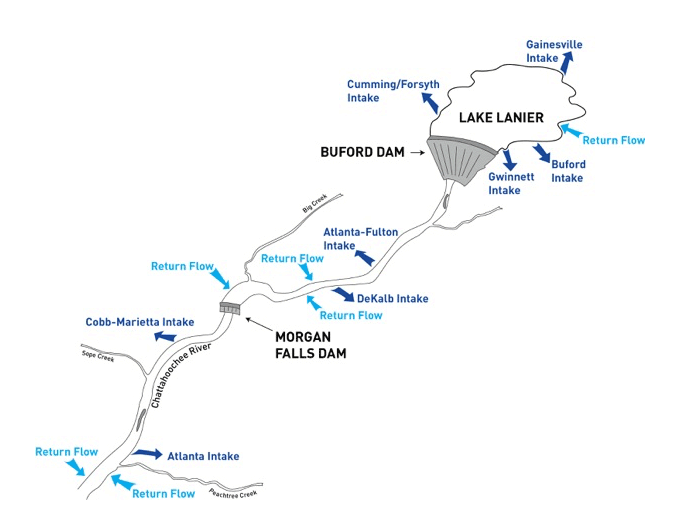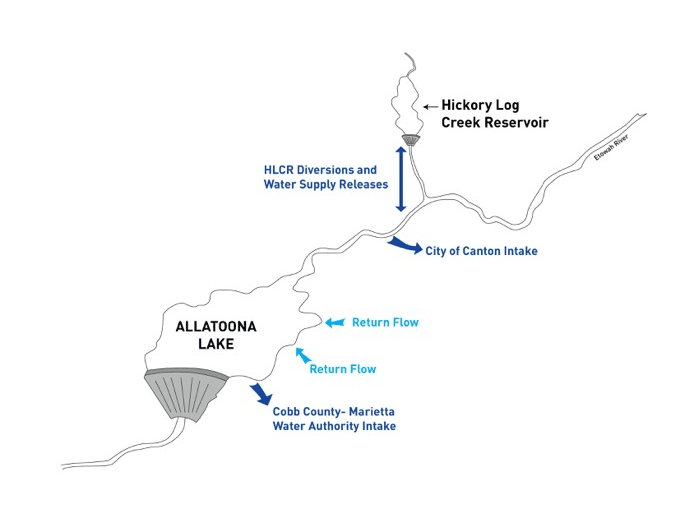NOTICE
ARC statement on the Landmark Apalachicola-Chattahoochee-Flint Agreement
This is a win-win solution that establishes a clear path to resolve the decades-long dispute over our shared water resources. We appreciate the leadership of Governor Kemp and Governor Ivey and the willingness of all parties to find common ground.
As leaders in water stewardship, we are gratified the parties have come together on an agreement that both protects metro Atlanta’s water supply and provides the downstream flows Alabama requested. We look forward to participating in the Corps’ public comment and environmental review process and are eager to find new opportunities to collaborate outside of the courtroom.
Read more …

Communities in metro Atlanta lie at the headwaters of two river basins that are shared by Georgia, Florida, and Alabama—the Apalachicola-Chattahoochee-Flint (ACF) River Basin and the Alabama-Coosa-Tallapoosa (ACT) River Basin. These river systems are used to meet multiple needs throughout the three states, including drinking water, power generation, agriculture, aquaculture, navigation and recreation.
Because of the granite geology underlying metro Atlanta, groundwater resources in the area are extremely limited. As a result, metro Atlanta depends on surface water (water in rivers in lakes) for its water supplies.
While metro Atlanta is located in an area with generally abundant rainfall, river flows are not always sufficient to meet the area’s water supply needs, especially during the summers and during periods of drought. Therefore, metro Atlanta depends on the ability to store water in two reservoirs operated by the U.S. Army Corps of Engineers (Corps) to provide safe and clean water supplies for its residents and businesses.
Lake Lanier is located in the ACF Basin on the Chattahoochee River, about 50 miles upstream of Atlanta. Some metro Atlanta communities in the ACF Basin withdraw water stored in Lake Lanier directly from the reservoir. Other communities withdraw water from the Chattahoochee River below the reservoir. These communities also depend on water stored in Lake Lanier because they rely on water released from the reservoir to meet their water supply needs. 
In the ACT Basin, the Cobb County-Marietta Water Authority and City of Cartersville withdraw water from Allatoona Lake, while the Etowah River both upstream and downstream of the lake supplies water to other jurisdictions. In addition, the Cobb County-Marietta Water Authority has constructed the Hickory Log Creek Reservoir, which will be used to store water and to supplement water supplies from Allatoona Lake.

Background of the Tri-State Litigation
The ACF and ACT Basins lie at the center of more than two decades of litigation between Alabama, Florida and Georgia. During the 1980s, the state of Georgia, the Atlanta Regional Commission (ARC), the Corps, the U.S. Environmental Protection Agency, and others collaborated on a multi-year study looking at how metro Atlanta communities should meet their water supply needs. This study concluded that the most environmentally sensitive and cost-effective solution was for metro Atlanta communities to use water stored in Lake Lanier and Allatoona Lake.
In 1989, the Corps released a draft plan to implement the study’s recommendations. This plan would have allowed metro Atlanta communities to purchase storage space in the Corps’ reservoirs so they could store water for municipal and industrial water supply. In return, metro Atlanta communities would sign storage contracts agreeing to pay the federal government for the entire cost of constructing the portions of the reservoirs they were using, along with their fair share of the costs of operating and maintaining the projects. At the time, the Corps concluded that metro Atlanta’s water supply uses would have “no significant environmental impacts.”
The “Tri-State Water Wars Litigation” began in 1990, when Alabama sued the Corps to prevent it from finalizing this plan. Georgia and Florida joined the litigation, and it was stayed several months later to give the states and the Corps time to negotiate. In 1992, Alabama, Florida, Georgia and the Corps entered into a Memorandum of Understanding, agreeing to suspend the litigation while conducting a “comprehensive study” of the water resources in the two basins. The three states and the Corps also agreed that metro Atlanta communities could continue to withdraw what water they needed, and even increase withdrawals, to meet reasonable increases in demand, while the study was in progress.
The comprehensive study was never completed, but it led to the ratification of interstate water compacts for each basin in 1997. In reality, the compacts were agreements to negotiate—they established a framework to negotiate a formula to determine each state’s fair share of the water but they did not actually divide the water among the three states. Like the 1992 agreement, however, each compact allowed metro Atlanta communities to make reasonable increases in withdrawals to meet growing demands. Unfortunately, the states were unable to reach agreement. Negotiations on the water allocation formulas failed in the ACF in 2003 and in the ACT in 2004, at which point the compacts dissolved.
Litigation resumed with the termination of the compacts. It quickly mushroomed from the single case filed by Alabama in 1990 to eight separate cases in six different federal courts in Alabama, Georgia, Florida, and Washington, D.C., all challenging various aspects of the Corps’ operation of its reservoirs. Some of these cases focused on the Corps’ operations of the dams and withdrawals by metro Atlanta for drinking water supplies. Others challenged the Corps’ compliance with environmental laws, such as the Endangered Species Act and the National Environmental Policy Act. The ACF cases were consolidated in federal court in Jacksonville, Florida, while the ACT case remained in federal court in Alabama.
Although there were many steps along the way, the cases were ultimately resolved in 2011 and 2012, respectively. In the ACF, the federal court in Jacksonville issued a decision 2010 that rejected claims by Florida that the Corps’ operations violated the Endangered Species Act, which Florida did not appeal. This was followed in 2011 by a decision from the United States Court of Appeals for the Eleventh Circuit, which included two key rulings:
- First, the Eleventh Circuit dismissed the cases brought by Alabama, Florida and others challenging the Corps’ water supply operations at Lake Lanier. The court explained that Alabama, Florida, and the other plaintiffs had filed suit too early, and thus prevented the Corps from taking action to finalize its water supply operations.
- Second, the Eleventh Circuit ruled that Congress had specifically authorized the Corps to provide water from Lake Lanier to meet metro Atlanta’s water supply needs when it authorized the Corps to construct Lake Lanier. The court explained that Congress understood metro Atlanta’s water supply needs would grow as the area developed into the future, and recognized the value of providing an “assured” supply of water to metro Atlanta.
The court directed the Corps to evaluate how much water it could provide to metro Atlanta under this clarified authority, and to make a final decision regarding its water supply operations at Lake Lanier. In 2012, the Army released a legal opinion finding that it could supply up to 705 million gallons per day to metro Atlanta, but that any final decision on water supply operations would need to be made after environmental studies are completed. The Corps is in the process of completing those studies now, and a final decision is expected in 2017.
In the ACT, the court ruled in 2012 that Alabama’s challenges to the Corps’ water supply operations at Allatoona Lake were also premature and dismissed Alabama’s case Later that year, Alabama voluntarily dismissed its last remaining claim challenging Cobb County-Marietta Water Authority’s construction of the Hickory Log Creek Reservoir, thus bringing the first round of the Water Wars litigation to a close.
A timeline of significant events in the ACF and ACT litigation:
ACF and ACT Lawsuits (1990-2012)
|
1946
|
Congress authorizes construction of Buford Dam and Lake Lanier in the River and Harbor Act of 1946. The Act recognizes that a primary purpose of Lake Lanier is to meet Metro Atlanta’s water supply needs as they grow into the future.
|
|
1963
|
CCWMA enters into a contract with the Corps, authorizing it to store water in Allatoona Lake for water supply.
|
|
1970s
|
The Corps, Georgia, ARC, EPA and other federal agencies and local governments engage in a multi-year study of how best to meet Metro Atlanta’s long-term water needs. Ultimately, the “Metropolitan Atlanta Area Water Resources Management Study” (MAWRS) concludes that a “reregulation dam” should be constructed below Buford Dam and Lake Lanier in what is now the Chattahoochee River National Recreation Area. This dam would capture peaking hydropower releases from Buford Dam, making them available to meet water supply needs into the future.
|
|
1981
|
CCMWA requests that it be allowed to purchase additional storage space in the Allatoona Lake.
|
|
1986
|
Congress authorizes the Corps to construct the reregulation dam envisioned by the MAWRS in the Water Resources Development Act of 1986.
|
|
1989
|
After reconsidering the environmental and economic impact of the reregulation dam, the Corps decides that the most efficient means to meet long-term water needs is to “reallocate storage” in Lake Lanier and Allatoona Lake.
The Corps releases a Draft “Post-Authorization Change Report” proposing to reallocate storage in Lake Lanier instead of constructing the previously authorized reregulation dam. At the same time, the Corps releases a draft proposal to reallocate more storage in Allatoona Lake for water supply to CCMWA and the City of Cartersville.
The Corps proposes to issue new storage contracts for Lake Lanier and Allatoona Lake, under which Metro Atlanta water suppliers would reimburse the federal government in today’s dollars for the cost of constructing the reallocated storage.
|
|
1990
|
The state of Alabama begins the litigation by filing suit against the Corps to block proposed actions in the ACF and ACT basins.
Over time, other lawsuits by various parties are filed and eventually all of the ACF cases are consolidated in federal court in Jacksonville, Florida before Judge Paul Magnuson. The cases were heard in two phases – one addressing challenges to the Corps of Engineers’ authority to operate Lake Lanier for water supply and the second dealing with issues surrounding the Endangered Species Act.
|
|
1992
|
Alabama, Florida, Georgia, and the Corps sign a Memorandum of Agreement under which they agree to stay Alabama’s lawsuit and study the ACF and ACT Basins so they can reach a water-sharing agreement.
|
|
1997
|
The states adopt interstate compacts for the ACF and ACT Basins. The compacts do not include a water allocation formula, leaving that to future negotiations. The compacts specifically provide that water suppliers in Metro Atlanta can increase withdrawals to meet reasonable increases in demand, which all parties understood would occur.
|
|
2004 – 2007
|
Alabama terminates the ACT Compact and resumes litigation. Alabama challenges the Corps’ water supply operations and CCMWA’s water supply withdrawals from the reservoir.
|
|
2008
|
CCMWA completes construction on the Hickory Log Creek Reservoir. Alabama challenges the Clean Water Act permit authorizing construction of the project.
|
|
July 17, 2009
|
Judge Magnuson issues a ruling declaring that water supply is not an authorized purpose of Lake Lanier, and imposes, in his words, a “draconian” injunction that would have cut metropolitan Atlanta’s water supply in half. Georgia is given three years to obtain Congressional approval for additional authorization.
Memorandum and Order of the U.S. District Court, Middle District of Florida, In re Tri-State Water Rights Litigation (Phase I)
|
|
September 2009
|
The state of Georgia, the other Georgia parties (ARC, Cobb County-Marietta Water Authority, the City of Atlanta, DeKalb County, Atlanta-Fulton Water Resources Commission, the City of Gainesville and Gwinnett County) and the U.S. Army Corps of Engineers appeal the district court ruling. The 11th Circuit Court of Appeals agrees to hear the case, over Alabama and Florida’s objection.
|
|
July 21, 2010
|
Judge Magnuson issues a ruling rejecting all claims by Florida that Corps’ operations violate the Endangered Species Act. He directs the Corps to prepare an updated Environmental Impact Statement under the National Environmental Policy Act that fully considers the effects of current and future water supply withdrawals from Lake Lanier, explaining that “all decisionmakers would benefit from the comprehensive analysis of a range of potential activities in the ACF basin.”
Florida appeals, but later dismisses its appeal voluntarily.
Memorandum and Order of the U.S. District Court, Middle District of Florida, In re Tri-State Water Rights Litigation (Phase II)
|
|
June 28, 2011
|
The 11th Circuit overturns Judge Magnuson’s decision, finding that water supply is a fully authorized purpose of Lake Lanier. The Court of Appeals explains that Congress intended Lake Lanier to be a primary water supply source for metro Atlanta, and thatCongress understood when it authorized the project that water supply needs would grow as the population of metro Atlanta increased.
The Court of Appeals also dismisses challenges by Alabama, Florida, and others to the Army’s water supply operations, finding that Alabama’s suit was filed before the Army could make any final decisions about how the project should be operated.
The 11th Circuit gave the Corps one year to reevaluate its authority to meet metro Atlanta’s future water supply needs in light of the court’s conclusion that water supply is an authorized purpose of Lake Lanier.
11th Circuit Court Ruling
|
|
June 25, 2012
|
As directed by the 11th Circuit, the Corps issues a legal opinion concluding that it has the legal authority to grant Georgia’s entire water supply request, which would allow withdrawals from Lake Lanier and the Chattahoochee River of 705 million gallons per day. The opinion states, however, that an environmental impact statement would need to be completed before any final decisions can be made.
The Corps’ Opinion
|
|
June 2012
|
The U.S. Supreme Court effectively upholds the 11th Circuit’s decision. The Court denies requests by Alabama, Florida, and others seeking review of the 11th dismissal of their suits against the Corps and by denying Alabama’s and Florida’s requests to review the 11th Circuit’s key holding that water supply is an authorized purpose of Lake Lanier.
|
|
July 2012
|
The U.S. District Court for the Northern District of Alabama dismisses Alabama’s challenges to the Army’s operation of Allatoona Lake and CCMWA’s water supply withdrawals for lack of jurisdiction. This resolves identical claims brought by others in Alabama, including Alabama Power Company.
The Court’s Opinion is available here .
|
|
October 2012
|
Alabama voluntarily dismisses its challenge to the permit that authorized construction of the Hickory Log Creek Reservoir, which has already been built.This brings the original “Water Wars” litigation to a close.
|
ACF and ACT Lawsuits (2013 – Present)
Following the close of the original “Water Wars” litigation in 2012, a new series of legal actions began in 2014 over the ACF in the Supreme Court, the ACT Water Control Manual and other ACT issues, and the ACF Water Control Manual update.





